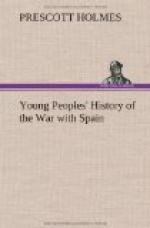“While lying in the hospital, I heard a young man named Hall, who belonged to the Twenty-second Infantry, tell a story which will illustrate better than anything else the accuracy of the American shooters. He and five other men had crossed a bend in a road to get some water in their canteens. As they got into the open they were attacked by thirty-two Spanish cavalrymen, who cut them up badly with their sabres. Hall was the only one who was not killed. He was badly trampled by the horses, and had some sabre wounds on his body. Later on, Hall was picked up by some comrades to whom he told his story. These men located the Spaniards who had done the work and opened fire on them. When they had ceased firing there were thirty live horses, two dead ones, and thirty-two dead Spaniards. This was pretty good shooting, wasn’t it?”
Many heroic deeds were done in the Battle of Las Guasimas, by the “Regulars” as well as by the “Hough Eiders.” Suffering was bravely borne. Sixteen of our men were killed, and more than fifty wounded. Yet all our troops took heart from the victory of that day, and began to think it would be easy to go on driving the Spaniards back to Santiago, and then to take that city. But it did not prove to be easy.
There is a little railroad which runs from some mines near Santiago to the pier at Daiquiri. Before the landing was made, the Spaniards were driven from the coast by the shells of the American fleet. Before they hurried away they attempted to disable a locomotive which had steam up. They took off the connecting rods, throttle gear and other important parts of the machinery and hid them behind fences and other places where they thought they would not be found. Then they blocked the piston guides and ran off. But there were plenty of engineers and mechanics among the American soldiers, and when they saw the condition the locomotive was in they started to search for the missing parts. Most of these were found and the machinery was cleverly patched up. Then they knocked the blocks of wood out of the slides and threw fresh coal into the firebox, and in a very short time the locomotive was pulling a train of ore cars loaded with soldiers.
[Illustration: (Soldiers at rest)]
CHAPTER IX.
El Caney and San Juan.
For a few days after the battle of Las Guasimas no great event took place. There was no fighting. The other troops were making their way up from the coast, but the roads were so narrow and so bad that progress was slow. The army wagons had great trouble to get on, and many supplies were left at the coast or on the boats, because there was no proper way of taking them forward. The heavy cannon were hauled a few miles from the coast and then most of them were left, though they would have been a great help to our Army, and should have been taken to the front.




